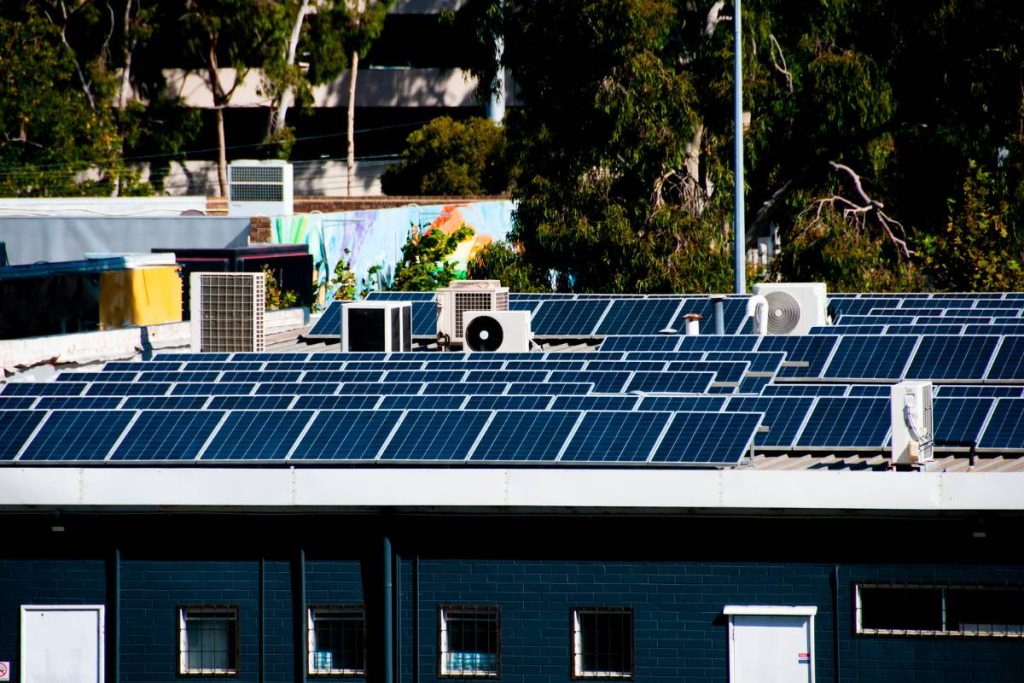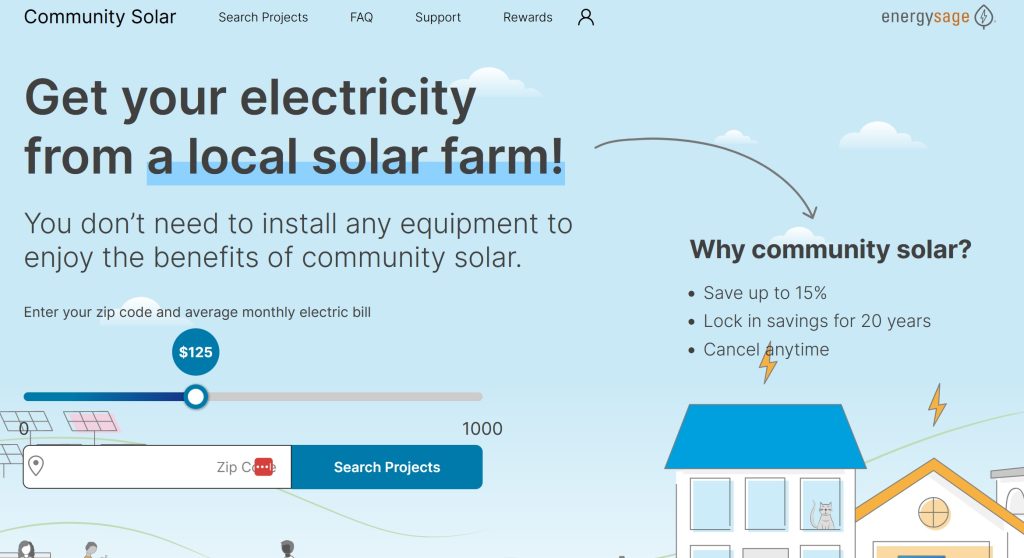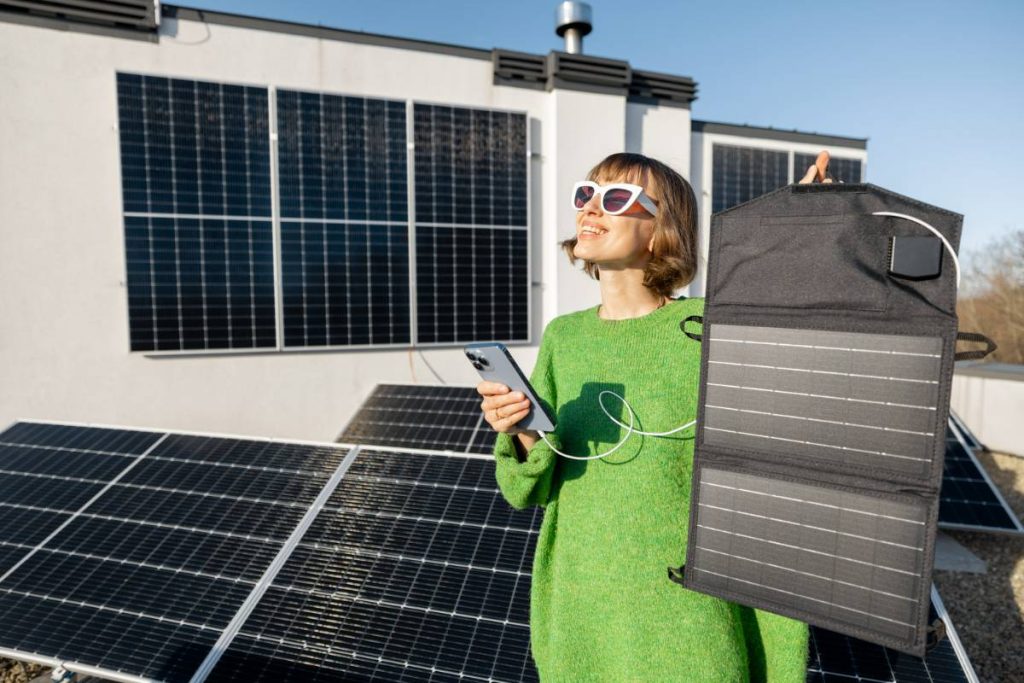Apartment buildings and rental properties can harness solar power through creative solutions like participating in community solar programs, mounting panels on a stand, using solar kits, integrating solar windows, and investing in portable solar systems, even if they don’t have access to a suitable roof.
Based on my experience, I have seen many renters successfully integrate solar power systems in their apartments or condos. Suppose you understand the basic solar panel specifications; I encourage you to look into these possibilities and take a step forward to save money, raise the value of your apartment building, and create a more sustainable future.
#1. – Join a Community Solar Project

A program called community solar, commonly referred to as a shared solar system, allows several people or organizations to benefit from a single large solar farm installation. These installations can be put in place wherever there’s access to sunlight, whether on the ground, a rooftop, or some other surface.
In recent years, community solar projects have gained popularity as a method for people to benefit from solar power without the upfront cost and maintenance of solar panels on their own roofs, houses, or businesses.
In apartment buildings, community solar can help to reduce carbon footprint by promoting sustainable energy practices. Individuals and apartment owners can promote clean energy by taking part in a project and inspiring their neighbours to do the same.
In a typical community solar project, participants receive credits on their energy bills for the electricity their portion of the installation generates —similar to how rooftop solar system owners receive monthly credits. Community solar participants can receive credits on their electricity bills through incentives such as virtual net metering which can help them save money each month.
How to join a Community Solar Project
Joining a solar community project is usually a simple process. Finding a project in your neighbourhood is the initial step. This may frequently be accomplished by conducting online research or contacting nearby solar installation businesses. After choosing a project, you must choose your level of involvement and register for the project.

To do so, go to the community solar project website (Energysage), enter your zip code, and average monthly electricity bill to see if any projects are available for you to sign up for.
Take a look at the list of nearby community solar projects. Pick a good project you want to participate in. To find out more about the project’s expected cost savings, billing details, and estimated environmental impact, check out the community solar project reviews and details.
The requirements for joining a community solar initiative will vary depending on the program, but typically include providing your utility account information and accepting to follow the program regulations. Once you have enrolled, you can start seeing credits on your electricity bills for the amount of electricity that your share of the installation has produced.
Participating in community solar projects enables people to lessen their carbon footprint through clean energy projects, lower their energy costs, and support the use of green power by displacing fossil fuels.
#2. – Purchase Green Energy for Your Home
Electricity produced from renewable resources, such as wind, sun, geothermal, and biomass, is known as “green power.” The EPA (Environmental Protection Agency) defines green power as the fraction of renewable energy that has the greatest environmental impact.
Purchase Green Power from Your Utility Directly
Most utilities provide green power programmes, which let users buy a particular amount or proportion of their energy usage from clean energy sources. Some programmes that generate electricity might offer fixed-rate pricing, while others would propose a premium rate for green power. The amount of green energy you purchase will be shown on your monthly bill, and you will still get the same reliable service from your utility provider.
It’s important to do your research, compare costs, and look into your options before deciding whether to buy green power from your utility company directly. Different programs may offer flexible options or have minimum commitment requirements.
Also, it’s important to confirm that the green energy you are purchasing comes is certified and comes from a renewable energy source. Your utility supplier should be open and honest about the source of energy and how it is monitored.
Purchase RECs
A megawatt-hour (MWh) of renewable energy production is represented by a certificate known as a renewable energy certificate (REC). Purchasing Renewable Energy Certificates (RECs) is another choice for individuals as well as organizations interested in saving money by reducing their carbon footprint. Independent organisations that track and certify clean energy production issue RECs for every MWh of energy produced.
Investing in RECs (renewable energy certificates) provides the benefit of promoting green power beyond your local region. RECs can be purchased from renewable energy projects anywhere in the country. You can continue to get dependable service from your current utility supplier and acquire RECs without any modifications to your current electricity service.
The green rate plans offered by your utility likely to employ RECs, but you can also purchase RECs directly from accredited suppliers.
#3. – Buy Portable Solar Panel System

Although rooftop solar panels are a popular way to harness the sun’s energy, apartment dwellers may not always have access to them. Fortunately, portable solar panels present a useful and practical alternative for individuals living in apartments. They are portable, lightweight, and simple to set up in different locations.
To get started, select a portable solar panel that fits your energy requirements and budget. With the different options available in the market, It is important to pick a portable solar panel that meets your energy needs.
Once you have your panel, you can place it in an area that receives good sun exposure. This could be a patio, a windowsill, or a balcony. Be sure to place the panel such that it receives the most sunlight possible.
When it’s time to use the portable solar panel, plug your appliance into the inverter. The stored energy will be converted by the inverter into a form that your devices can use.
#4. – Solar Windows
A revolutionary technology, solar windows have the potential to change the way we think about energy and construction. As these technologies keep developing, we can anticipate seeing solar windows employed in more buildings in the near future.
Current research is focused on enhancing the effectiveness and lifespan of a solar window. Solar windows are positioned to play a significant role in the clean energy landscape and assist in a more sustainable future as a result of the growing demand for clean energy.
The National Renewable Energy Lab has been developing thermochromic technology to perform two functions. The heat from direct sunlight causes the window to darken in order to absorb light, block glare, and minimise excess heat indoors, while also causing the generation of solar energy. When the sunshine disappears, the window returns to its original transparency.
#5. – Solar Window Socket
The Window Socket, a portable solar energy converter that attaches to the window and allows you to plug straight into the device, is a much more compact but highly useful product in development. The device would contain a 1000mAh solar battery that could power a phone or other electronic devices.
The portability of a solar window socket is one of its perks. It can be carried from room to room or even taken with you on the go because it is not permanently attached.
#6. – Review the Lease Agreement
Check your rental contract to make sure solar panels for apartments are permitted before thinking about installing solar panels in your rental apartment. Consult your landlord or property management if you have questions regarding your options.
Request Your Landlord to Install Solar Panels
Here are some tips to persuade your landlord to install panels in your apartment complex.
Talk about the Benefits of a Solar Power System
Make sure your landlord is aware of the benefits of solar energy, which include lower energy costs, increased property value, and environmental sustainability.
Provide Examples of Apartment Buildings with Solar Panels
Look up examples of other flat buildings that had solar panels installed, then present them to your landlord. This will strengthen your case and demonstrate the feasibility of solar panels for your apartment.
Provide your landlord with information and resources on solar panel installation and the advantages it might have for their property. This may offer details on nearby tax credits, financing possibilities, and solar incentive programmes.
Discuss the Energy Demands and Savings for the Apartment
To prove the financial savings and environmental benefit to your landlord, you’ll need to run the numbers. Requesting estimates from nearby solar installers may even be a good idea. One easy way to do it is to explore online solar calculators.
Enter your pin code, house address, property type, and average monthly bill in the online calculator and wait for the output generated by the calculator.
This solar calculator accounts for savings based on whether your landlord opts for a zero-down loan or pays the entire cost upfront. Using this calculator, I found that over a 20-year period, my rental property might save up to $50,000.
Respond to any inquiries or objections
Installing solar panels could be opposed by your landlord due to worries about potential roof damage or inability to recuperate the installation cost. Be prepared to address these issues and offer solutions or substitutes.
Do not forget to conduct yourself professionally and with respect during the conversation. Provide your landlord with as much information as you can to enable them to make an informed choice.
Wrap-Up Thoughts
It is possible to use solar panels for apartments, even if your apartment does not receive direct sunlight and your landlord is unwilling to install solar panels.
It’s important to understand that the viability of various solar options will be determined by a number of parameters, including your location, energy consumption, roof space, and local projects and incentives. Here are a few more things to think about:
Cost: While solar energy might save you money on your utility bills in the long run, there can be high upfront payments involved with the installation. Community solar may be less expensive than rooftop solar.
Credits: Depending on where you live, you may be eligible to obtain credits for the excess energy produced by your solar panels. This can help offset installation costs and make solar power more financially viable.
Long-term plans: If you intend to stay in your rental apartment for an extended period of time, a rooftop solar power system could be a suitable investment. But, if you intend to relocate soon, a community solar plan may be more realistic.
